Using yeast to untangle the complexity of life
The challenge
The 1002 Yeast Genomes project was a ground-breaking effort to map the total phenotypic variation of the Saccharomyces cerevisiae genome on a global scale. This was a challenge of epic proportions, so when co-founder Professor Joseph Schacherer visited our our headquarters in 2018, hot off the heels of the project’s publication in Nature, we were keen to ask what motivated the project?

“My motivation comes from a fascination with the complexity of nature. If you look at individuals of a species, they really differ, but we still don’t know why and I think explaining this natural variation is really exciting,” was Joseph’s response, with postdoc Teo Fournier adding: “It’s trying to understand the unknown and the thrill of discovering something new or giving clarity to a given problem; call it the thirst for novelty and discovery.”
At the project’s inception in 2013, yeast population genomic studies had been limited to a small number of isolates (less than 100 strains). Together with Gianni Liti and Genoscope, The Schacherer group co-founded a mission to take that figure to more than 1,000 yeast isolates sourced from a wide variety of different ecological and geographical backgrounds.
Joseph knew the task would be enormous: “It’s easy to get a thousand wine strains, but that’s not how we wanted to proceed,” was his candid response to The Atlantic when asked why they went to such lengths to uncover little-known wild strains from far flung corners of the world.
Equivalent large-scale programmes had already been accomplished in Arabidopsis thaliana and humans, but this was the first attempt to address a eukaryotic model system in such meticulous detail. However, Joseph had clearly been under no illusion about the scale of the undertaking:
“In our work we’re trying to find genomic regions that are related to some specific phenotype. Sometimes you get lucky and find a single region that is strongly involved in a trait. But often it’s more complex than that, requiring high throughput experimentation and data analysis, and making those interesting discoveries a much longer process.”
The solution
Fortunately for Joseph’s team, working in yeast meant 1002 genomes had several advantages over its forerunners in Arabidopsis and humans. Not least, the genetic manipulation of yeast is cheaper and significantly easier than more complex multicellular organisms, as Joseph explains:
“Yeast is such a powerful model organism to do genetic research with. Clearly, you’re not allowed to cross humans in the lab, plus humans don’t give too many progeny. This is easy to accomplish with yeast making it a great model for inheritance. Yeast is also easy to phenotype and the yeast genome is only 12 megabases long which makes it easy to sequence in order to study the relationship between genotype and phenotype. That’s just perfect. I think there will always be room for yeast because there’s stuff you can do that frankly can’t be done with any other organism.”

The team also had access to the fastest colony manipulation robot in the world, capable of accurately and reliably arraying nearly a million colonies per hour! We are of course referring to Singer Instruments’ ROTOR+ which, when combined with rapidly advancing next-generation sequencing technology, was able to shave not months but years off the time needed to complete the project. In fact, 1002 genomes achieved journal publication up to three years quicker than its 2008 predecessors, the 1000 genomes and 1001 genomes programmes. Put simply, Teo told us:
“For scalability and high throughput the ROTOR has allowed us to phenotype thousands of strains, which otherwise would not have been possible.”
Not long after the publication of their landmark paper, Joseph chose to add ‘PIXL’ to his microbial handling arsenal, an ultra high precision colony picker. PIXL and ROTOR+ combine to perform almost seamless end-to-end high-throughput screening workflows. It gave the team the efficiency and reliability they needed to continue the legacy from 1002 genomes, and move their experiments “from the micro to the macro”, says Joseph:
“We now have a new challenge that we think […PIXL] will be able to help solve. We have generated many segregants from crossing different isolates and what we want to be able to do now is handle them individually. We can achieve this with toothpicks but it’s time-consuming and also a source of error and so PIXL is going to be much better for us in many ways.”
“As a long-time customer, I can say that it is really nice to have tools from Singer Instruments. This is quality equipment and if you have a problem, which is to be expected, you know you can just email and someone will always respond.”

Professor Joseph Schacherer
Laboratory for Molecular Genetics,
Genomics and Microbiology (GMGM), University of Strasbourg
Want to know more?
Discover how Gianni Liti is continuing to accelerate high-impact science by harnessing natural genetic variation.
References
1. Peter, J., De Chiara, M., Friedrich, A. et al. Genome evolution across 1,011 Saccharomyces cerevisiae isolates. Nature 556, 339–344 (2018). https://doi.org/10.1038/s41586-018-0030-5
2. Joseph Schacherer. Domestication and genome evolution under the light of 1,011 yeast natural isolates. Behind the Paper, Nature Ecology and Evolution (2018).